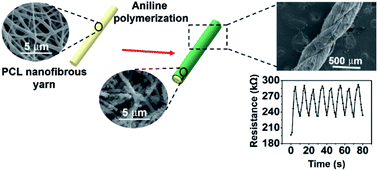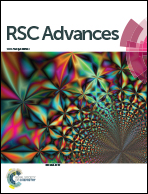All-organic, conductive and biodegradable yarns from core–shell nanofibers through electrospinning†
Abstract
Electrically conductive and biodegradable materials are desired for a range of applications in wearable electronics to address the growing ecological problem of e-waste. Herein, we report on the design and fabrication of all-organic, conductive and biodegradable nanofibrous core–shell yarn produced by in situ polymerization of aniline on the surface of electrospun poly(ε-caprolactone) nanofibers. The effect of concentration of aniline monomer on the morphology and resistivity of deposited polyaniline layer was investigated. The electrical resistance changed almost instantaneously with the strain for multiple stretch and recovery cycles. This rapid and sensitive response to mechanical loading and unloading is promising to validate the possibility of using the conductive yarns as strain sensors for monitoring human motion. Increasing the number of plies of yarn to three resulted in a three-fold reduction of the resistance. The twisted plied yarns were incorporated into fabric by stitching to demonstrate their use as a wearable electrode for capacitive sensors. This approach presents an early step in realizing all-organic conductive biodegradable nanofibrous yarns for biodegradable smart textiles.



 Please wait while we load your content...
Please wait while we load your content...